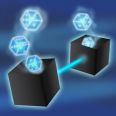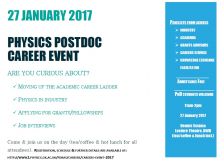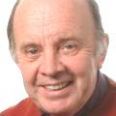Other
Miscellaneous
6 April 2017
Congratulations Luke Ceurvorst
Congratulations to Luke Ceurvorst who recently won the best poster prize at the 44th IoP Plasma Physics Conference on channelling results from OMEGA EP.
21 February 2017
Physics Colloquia Series Presents: Prof Tom McLeish FRS, Durham University 'Learning new physics from a medieval thinker: Big Bangs and Rainbows’
Friday, 24th February 2017 at 15:30
14 February 2017
Astor Special Lecture: Dr. Dmitri D. Ryutov
Physics Colloquia Series – Astor Lecture
Plasma physics helps in establishing an upper bound for the photon mass
Dr. Dmitri D. Ryutov
Lawrence Livermore National Laboratory
Tuesday, 7 March 2017 at 14.00
14 February 2017
Friday Physics Colloquia Series Presents (17 Feb): Professor Valerio Scarani, Centre for Quantum Technologies and National University of Singapore

‘The applied side of Bell nonlocality’
Friday, 17 February 2017 at 15:30
Postdoc Careers Event

Postdoc Careers Event
Are you a postdoc interested on how to optimize your career options in academia? Or curious on career opportunities beyond the Ivory Tower? Then come to the Physics Postdoc Careers Event this Friday - registration form & submission of questions to panellists through this form
7 November 2016
Edmund 'Ted' Wilson 1938 – 2016

It is with great sorrow that we mourn Edmund 'Ted' Wilson, who died on November 3rd 2016 after a short illness.
Ted was born on 18 March 1938 in Liverpool, the son of school teacher John Wesley Wilson and nurse Anna Wilson. He was a great accelerator physicist and an inspired and inspiring teacher. He was an engaging and entertaining companion, being one of those people who, while being quite serious about everything, never take themselves too seriously; he lived life to the full, doing as much good as he could along the way.
25 October 2016
Physics Colloquium Nov 11: Professor Jon Rosner (Chicago), 'Exotic combinations of quarks - A journey of fifty years'
The early 1960s witnessed a wealth of elementary particles described in terms of simple combinations of a few more elementary units, dubbed quarks. The known mesons and baryons could all be described as states of quark-antiquark or three quarks. However, it was not understood why certain more elaborate combinations, such as (two quarks + two antiquarks) or (four quarks + one antiquark) had not been observed. It has taken nearly half a century, but these "exotic" particles are now beginning to be seen and understood.
25 October 2016
Physics Colloquia Series Presents: Astro Special - Dr Jamie Holder,University of Delaware, presents 'Astronomy at the Highest Energies: Exploring the Extreme Universe with Gamma Rays'
The gamma-ray band of the electromagnetic spectrum probes some of the most extreme environments in the Universe. Photons of these very-high energies can only be produced by the interactions of subatomic particles that have been accelerated to almost the speed of light. This acceleration occurs in a surprisingly wide variety of astrophysical sources: close to black holes and neutron stars, in the blast waves of supernova explosions, and in the relativistic jets of active galaxies.
25 October 2016
Physics Colloquia Series Presents: Dr. Trevor Cross,Group Chief Technology Officer, e2v, entitled '60 years of imaging technology'
From the earliest commercial production of electronic image sensors for television in the 1950s, to the diverse application of specialist silicon image sensors for the Hubble space Telescope to digital dentistry this talk will outline the manufacturing technology and changes through 60 years at e2v. Somewhat surprisingly, there are today lessons to be learned, and technologies to be applied from this to the emerging new platform technology of ultra-cold atom sensing and metrology.
25 October 2016
Physics Colloquia Series Presents: Dr Cait McPhee, University of Edinburgh, entitled 'Proteins as switchable Janus ellipsoids'
Janus particles are micro- or nano-scale particles whose surfaces have two or more distinct physical properties. Such asymmetry results in interesting self-assembly properties, but homogeneous Janus particles can be difficult to synthesize. The protein BslA (Bacterial Surface Layer A) is a small (~4 nm) protein produced by the bacterium Bacillus subtilis that has a hydrophilic ‘body’ to which is appended a surface-exposed hydrophobic ‘cap’.


